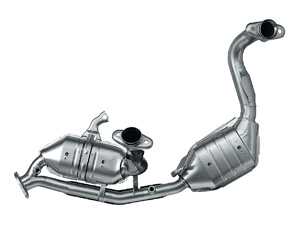A. On 1996 and newer vehicles with OBD II, the Check Engine light will usually come on and there will be a fault code P0420 or P0430 set (catalyst efficiency fault). A vehicle with bad converter won’t meet emissions or pass an emissions test unless the converter is replaced. Converters can fail for a variety of reasons. Most late model OBD II converters are designed to last 150,000 miles or more under normal driving conditions. But the converter may fail sooner for a variety of reasons, including contamination, engine misfire, rust, corrosion or vibration.
 Motor oil contains small amounts of zinc and phosphorus as an anti-wear additive. Phosphorus can poison the catalyst if an engine is using oil, so in recent years the amount of phosphorus in motor oil has been reduced to prolong the life of the converter. Even so, if the engine’s valve guides or rings are worn, oil can enter the exhaust and slowly poison the catalyst.
Motor oil contains small amounts of zinc and phosphorus as an anti-wear additive. Phosphorus can poison the catalyst if an engine is using oil, so in recent years the amount of phosphorus in motor oil has been reduced to prolong the life of the converter. Even so, if the engine’s valve guides or rings are worn, oil can enter the exhaust and slowly poison the catalyst.
A converter also can be fouled by coolant leaking into the combustion chamber past a bad head gasket. The silicates in some long-life coolants have the same effect as phosphorus on the catalyst. Ignition misfire, lean misfire and/or compression misfire are other conditions that can kill a converter rather quickly. Engine misfires or compression leaks that allow unburned fuel to enter the exhaust can overheat and damage the catalyst. A partial meltdown inside the converter may create a restriction or blockage that increases exhaust backpressure. This, in turn, will hurt fuel economy and performance, and may even cause the engine to overheat or stall. Converters may also succumb to rust, corrosion and physical damage.
The converter shell and heat shield are stainless steel, but do not last forever, especially in wet or corrosive environments where road splash and road salt are common. Cracks can develop in the converter mounting flanges or supports from vibration — especially if the exhaust system has some broken or missing hangars.
It may also be necessary to replace a converter because it has been stolen.
As the price of precious metals such as platinum and palladium go up, so has the theft rate for converters. Thieves crawl under a vehicle and cut off the converter so they can sell it to a scrap metal dealer for cash. To discourage this type of crime, a growing number of states now require anyone selling a used converter for scrap to show identification so the transaction can be recorded and documented.
Q. Does a replacement converter have to be the same type as the original?
A. Generally speaking, yes. There are four basic types of converters: “Two-way” converters in pre-1980 vehicles that reduce unburned hydrocarbons (HC) and carbon monoxide (CO); “Three-way (TWC)” converters in many 1980 and newer vehicles that reduce HC, CO and oxides of nitrogen (NOX); “Three-way plus oxygen” converters in newer vehicles that have additional plumbing to accept air from an air pump to reduce HC, CO and NOX; and “OBD II” converters that are essentially three-way converters certified to meet OBD II requirements on 1996 and newer vehicles.
California also has its own special requirements and rules for catalytic converters. For vehicles registered within the state of California, a replacement converter must be CA-certified with an A.R.B number stamped on the converter shell. But for CA vehicles that are no longer registered within California but are now registered in another state, the special CA converter may not be required. A 49-state converter may be acceptable provided it keeps emissions within OBD II operating perimeters and does not cause the Check Engine light to come on. California certified vehicles can be identified by referring to the underhood emissions decal.











